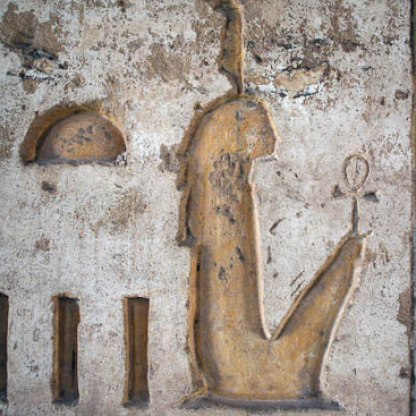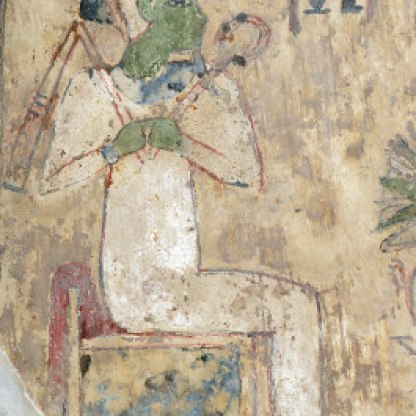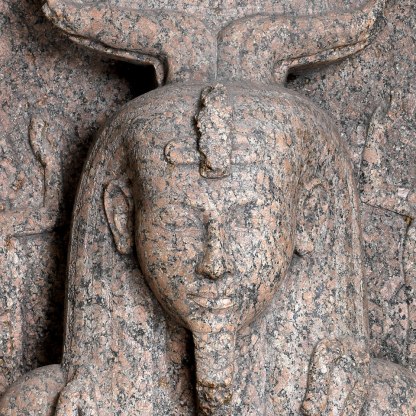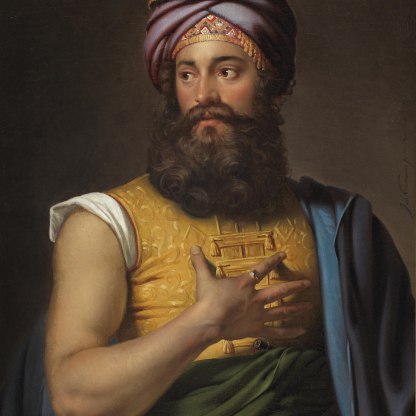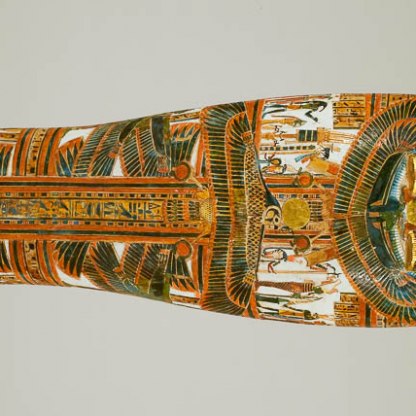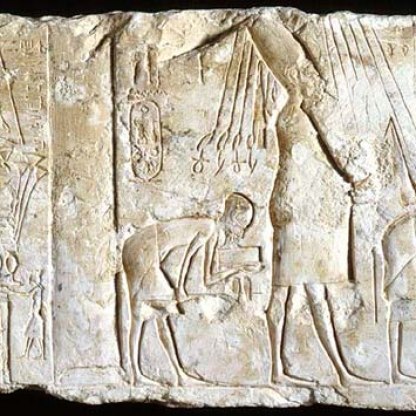Coffin Lid of Ramesses III

'The Osiris, King of Upper and Lower Egypt, Lord of the Two Lands... Son of Re, Beloved of the gods, Lord of Crowns, Ramesses, Ruler of Iunu...You are a god.'
These words are inscribed in hieroglyphs around the edge of this seven-ton slab of red granite, which once sealed the coffin of the great Egyptian King Ramesses III. It was transported to England in the early nineteenth century by the intrepid Italian adventurer Giovanni ‘The Great’ Belzoni.
The inscription addresses Ramesses as ‘the Osiris', and hails him as a god. It was believed that when Egyptian kings died they became Osiris, the powerful deity associated with death, resurrection and fertility. This god usually appears in Egyptian art mummified, holding a flail and crook in his crossed arms, and with a long, narrow, curled beard – we see him thus on a painted coffin in the Fitzwilliam [E.64.1996]. And it is in this form that Ramesses himself appears in the centre of his coffin lid.
His kingship is attested by the uraeus – the rearing cobra – on his forehead, and the tall crown comprising ostrich feathers, the sun disc and ram’s horns. These last two symbols associate him with the sun god Re, whose son the inscription proclaims him to be. The name Ramesses itself literally means ‘Born of Re'.
On either side, two goddesses put protective arms around the king. On the right as we look at the sculpture is Isis, the sister and wife of Osiris, recognisable by the hieroglyphic sign for ‘throne’ upon her head. Isis was the mother of Horus – the god with whom the living king was identified. A small bronze sculpture dating from between 715 and 525 BCE in the Fitzwilliam, below [E.122.1954], depicts this divine mother and son.

Opposite Isis is her sister Nephthys, who wears a hieroglyphic sign meaning ‘mistress of the palace’ on her head. She was the wife of the evil god Seth and mother of the jackal-headed Anubis, through a union with Osiris. She stands here upon the hieroglyphic symbol for ‘gold', detail right.
Between the goddesses and Ramesses are four snakes, two of which have female bodies and heads. These snake-women, who probably represent the goddesses Nekhbet and Wadjet, raise their hands in adoration of the dead king.
Though feared for their poison, snakes were also revered in ancient Egypt, and the fact that they regenerated their skins led to their being thought of as eternal beings. The snake provided an example from nature for the Egyptian belief in life after death. Another snake is carved all the way around the edge of the coffin lid alongside the inscription. This symbol – called the ouroboros – adds further protection for Ramesses.
The coffin lid as a whole is in the shape of a cartouche, the oval ring that enclosed the royal names of the Egyptian king. The cartouche was itself a hieroglyph, representing a length of rope with the ends knotted together at one end of the oval. This symbolised the circuit of the sun around the universe and implied that the king was master of everything within it.
The overwhelming themes of this huge carving, then, are resurrection, eternity and protection. Ramesses is the son of the sun, who dies at night only to rise again in the morning. He is Osiris, whose dismembered body was reassembled by his sister Isis. And he is protected by Isis and Nephthys and snakes, which live forever.
His reign on earth may be over, but the lid of his coffin suggests that Ramesses III is in fact more powerful than ever.
Themes and periods
Data from our collections database
Red granite sarcophagus lid of Ramesses III in the shape of a cartouche. In the centre of the lid is the king depicted as the god Osiris in mummy form. On his head he wears the Atef crown composed of ostrich feathers, a sun disk and a pair of ram's horns. Emerging from his forehead is a uraeus, the royal symbol of protection. The king also wears a long plaited beard, another divine symbol associated with the god Osiris, and a long wig with lappets. The king's arms are crossed over his chest and in his hands he holds the crook and flail. On either side are the standing figures of the goddesses Isis (Proper Left - PL) and Nephthys (Proper Right - PR). Much of Isis's figure is missing owing to a large break in the lid which extends from the back part of her head to the base (the break was probably caused by tomb robbers in antiquity). Nephthys stands on the hieroglyphic sign for gold 'nbw'. In between the depiction of Ramesses III and Isis and Nephthys are probably four snakes, two of which have female bodies and heads. These snake-women, who probably represent the goddesses Nekhbet and Wadjet, raise their hands in adoration of the dead king. Hieroglyphic text is inscribed around the lid's outer edge.
Sarcophagus lid of Ramesses III
July 1816 – Bernardino Drovetti meets Giovanni Belzoni and gives him the granite sarcophagus lid 12 August 1816 – Belzoni attempts to remove it March or April 1817 – Belzoni successfully removes it c. November 1817 – finds are shipped to Cairo 20 April 1818 – Henry Salt concedes a sarcophagus lid from the Valley of the Kings to Belzoni 27 January 1819 – Another shipment of finds from Luxor to Cairo and then Rosetta, including a sarcophagus lid May 1821 – shipped from Alexandria on the 'Dispatch' (Seti I’s alabaster coffin also on this ship) August 1821 – 'Dispatch' arrived in London Autumn 1821 – all objects moved into the courtyard of the British Museum March 1823 – Ramesses III's sarcophagus lid sent to Cambridge 31 March 1823 – lid arrives in Cambridge The link between Giovanni Belzoni and Cambridge is most probably The Reverend George Adam Browne who was associated with Trinity College. He was also a Freemason, like Belzoni.
Acquisition and important dates
- Method of acquisition: Given
- Dates: 1823
Dating
- New Kingdom
- 19th Dynasty
- Production date: 1200 BC
Maker(s)
Place(s) associated
- Thebes (Egypt)
Materials used in production
Read more about this record3D scan
Accessibility Notice:
The 3D model on this page is hosted on Sketchfab and may not be fully accessible to everyone, including users of assistive technologies. We apologize for any inconvenience.
Audio description
Stories, Contexts and Themes
Other highlight objects you might like
Suggested Curating Cambridge products
Sign up to our emails
Be the first to hear about our news, exhibitions, events and more…
